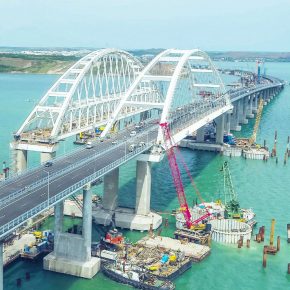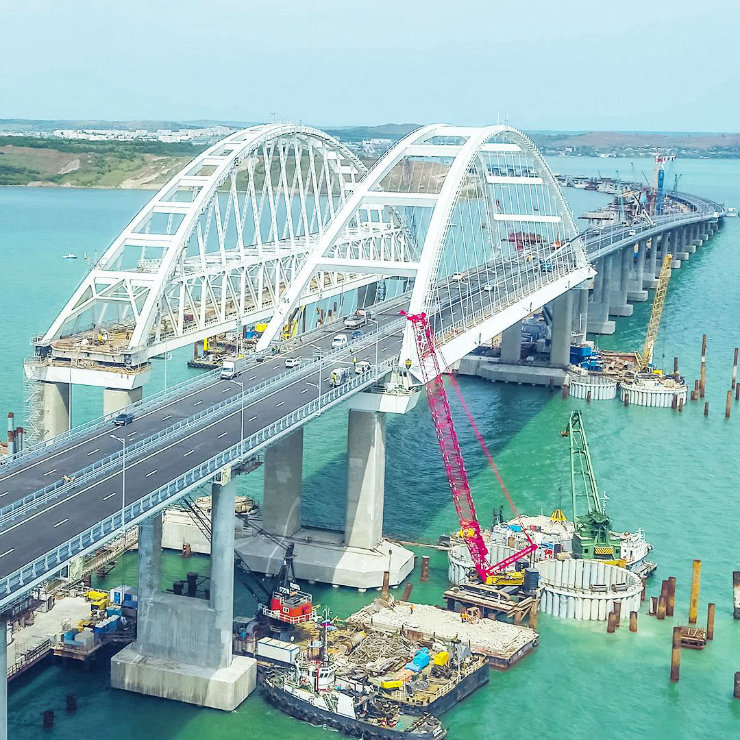
Kerch Strait Bridge, Sea of Azov, Ukraine (VMorozoff, CC BY-SA)
After losing control of the ports in Eupatoria, Sevastopol, Yalta, Theodosia, and Kerch, following Russia’s annexation of Crimea in 2014, Ukraine now controls 13 seaports with a total annual transshipment capacity of 260 million tons. These include, among others, the ports of Mariupol, Berdyansk, and Genichesk located on the Sea of Azov. In 2017, more than 20 per cent of the Ukrainian exports of steel, worth USD2.3bn, went through the port in Mariupol, while the port of Berdyansk — located only 80 kilometers away — was primarily used for the shipment of metallic ore and grains. Meanwhile, the port of Genichesk has been virtually unused for years. The unrestricted operation of these ports is guaranteed by the provisions of the Ukrainian-Russian agreement ratified in 2004, which sets out the rules for use of the Sea of Azov by both countries.
The first action taken by Russia that interfered with the navigation in the Sea of Azov was the construction of a bridge over the Kerch Strait. The bridge span hangs 33 meters above the waterway, thus limiting the passage of large vessels underneath it. Russia has also introduced „passive” impediments — it prohibited ocean-going ships with a length exceeding 160 meters from navigating in the Kerch Strait. The introduction of the new size limits prevents 144 vessels that had previously been using the Ukrainian ports from passing through the strait. This accounts for 23 per cent of the total number of vessels, but as much as 43 per cent of the cargo when tonage is taken into account.
Losses for shipowners
The ships approved for navigation, with a carrying capacity of 10,000 tons, are not ocean-going vessels, which means that cargo leaving Mariupol and Berdyansk can now only be transported to the ports of the Black Sea and the Mediterranean Sea.
In the spring 2018, the Russians started to actively impede navigation on the Sea of Azov. At the beginning of December, the Ukrainian Sea Ports Authority announced that as a result of these activities cargo transshipment in Mariupol declined by 8.9 per cent y/y, and the decline in Berdyansk reached 22 per cent.
According to the surveillance activities conducted by the BlackSeaNews website and the Kiev-based think tank Maidan of Foreign Affairs, in the period from May to the end of November 2018 Russians disrupted the passage of 741 ships bound for or leaving the ports of Mariupol and Berdyansk: 110 vessels were detained in the Azov Sea, including 30 ships flying the flag of EU member states or owned by a shipowner from the EU; 323 ships going to the Sea of Azov were detained for up to several days in the Kerch Strait, separating the annexed Crimea from mainland Russia; and 308 ships were detained on the way to the Black Sea.
The duration of the detentions is increasing. While in July 2018, the average detention of ships on route from the Black Sea to the Azov Sea lasted 28 hours, in November 2018 it already took 124 hours. Similarly, the average detention of ships on the way from the Azov Sea to the Black Sea lasted 57 hours in July 2018 and 115 hours in November 2018.
Experts estimate that the detention of a ship costs the shipowner approximately USD15,000 per day — which means that average losses resulting from a single detention reach USD75,000. It is therefore no wonder that the shipowners are increasingly avoiding the problematic route.
The authorities in Kiev only started to respond to these activities after a few months, when their economic consequences became acutely noticeable. The Russian blockade comes as yet another — possibly fatal — blow to the Azov ports, following the war in the Donbass region, which had already dramatically reduced the flow of cargo.
According to the management of the local port, since 2014 the transshipment volume in the frontline city of Mariupol fell from 14 million tons per year to just 5.5 million tons per year, while the resulting losses reached a total amount of UAH6bn.
The port in Berdyansk has implemented only 52 per cent of the transshipment volumes planned for the first three quarters of 2018, which translated into losses of up to USD4m. Because of the blockade the working time of the port crew had to be reduced to 4 days a week, but it was already announced that one-third of the employees would be made redundant. The port’s losses will negatively affect the local budget, as the taxes paid by the port accounted for 10 per cent of the city’s budget.
Grain exports will be affected
The negative impact of the blockade isn’t limited to the ports. Its effects are strongly felt throughout the entire Ukrainian economy. The Kiev-based National Scientific and Research Institute of Economic Modelling and Information Technologies conducted a simulation of the impact of Russia’s blockade of the flow of goods arriving from and to Ukrainian ports through the Kerch Strait. In the negative scenario assuming a complete blockade and lack of any actions aimed at mitigating its negative effects on the part of the authorities in Kiev, Ukraine’s GDP would decrease by 12.7 per cent and the revenues of the state budget would decrease by 16.5 per cent. Industrial production would fall by 14.3 per cent, while the value of services would decline by 12.7 per cent. The Russian blockade would impact the metallurgical industry the most — production in this sector would fall by 21.9 per cent. Meanwhile, the production of building materials would drop by 8.7 per cent. The decline in the energy industry is projected to amount to 8 per cent, and the fall in turnover in the sector of transport is supposed to amount to 6 per cent.
However, Ukrainian scientists emphasize that such a scenario for the future development of the situation is unlikely to materialize. A more realistic scenario is one in which a portion or even all of the cargo traffic would be reoriented to the ports on the Black Sea, and the country would avoid catastrophe, even though the negative effects of the blockade would still be felt. In such a scenario, Ukraine’s GDP would fall by 1.77 per cent, industrial production would drop by 3.1 per cent, and the value of services would decline by 0.17 per cent. On the other hand, the turnover in the transport sector would increase by about 0.75 per cent. However, the implementation of this scenario would take some time and would require financial and organizational outlays necessary for the modernization of the infrastructure.
The situation in the Sea of Azov could lead to the exclusion of two Ukrainian ports — Mariupol and Berdyansk — which recorded total transshipment volumes of about 9 million tons of cargo in 2017. This would affect the exports of steel from the metallurgical plants in Mariupol and the export of grains, which provided the foundation for the activity of the port in Berdyansk. The exports of building materials from the areas of Donbass controlled by the government would also be affected — assesses Serhiy Vovk from the Center For Transport Strategies. The blockade of the Sea of Azov necessitates the reconstruction of the logistics chains, which is possible but will require time and financial expenditures. This would generate additional costs for the exporters and, consequently, reduce their ability to compete on the global markets. “A reduction in the exports of two commodity groups that are crucial from the point of view of the Ukraine’s trade balance would acutely impact Kiev’s foreign currency inflows and would hurt the financial system,” says Vovk.
According to estimates, reorientation of export flows to the ports of Nikolaev and Odessa would increase exporters’ costs by USD8-10 per 1 ton of cargo.
The Ukrainian Institute for the Future estimated that the total losses caused by the Russian blockade of the Ukrainian ports on the Sea of Azov could reach USD200m per year.
High hopes for cabotage shipping
The Ukrainian central bank, NBU presented its assessment of the costs of the Russian blockade. “New losses caused by the Russian blockade will not be as large as in the summer months,” said Dmitry Solohub, the Deputy Chairman of NBU. This is due to the fact that the Sea of Azov cannot be navigated for a significant part of the winter season, anyway. Additionally, the Ukrainian railways have already announced that they would provide assistance in the reorientation of the logistics routes towards the Black Sea ports. Russian actions will affect 30 per cent of the Ukrainian metallurgical exports, with a total value of about USD230m per month. According to NBU, the associated losses will reach tens of millions of USD per month.
Experts have not ruled out the possibility that the Russian blockade of ship traffic in the Kerch Strait could lead to the development of cabotage shipping along the Ukrainian coast of the Azov Sea. This would allow for the transportation of steel from Mariupol, which has poor rail links with the rest of the country, to the port of Berdyansk, which is much better connected with other regions, and to the port in Genichesk, located near the demarcation line with the annexed Crimea, which isn’t really utilized at present.


